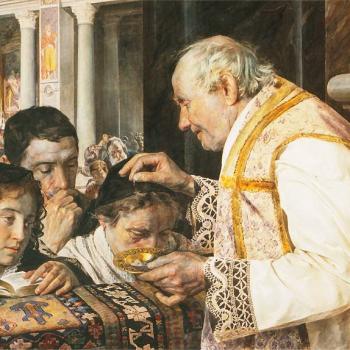As a lifelong lover of books, I’ve often encountered authors whom I really can’t say I like that much– and yet, I keep on reading them. And sometimes, if I read them long enough, I eventually grow to respect and even enjoy them. For me, one of these writers is the great British fiction writer and essayist C.S. Lewis, known best for his Christian apologetics.
As a child, I loved Lewis – indeed, The Lion, the Witch and the Wardrobe was probably the first piece of famous, high-quality children’s literature that I read. I was completely drawn into the story, the wondrous landscape of Narnia, the suspense of the children’s quest. But when I read his Space Trilogy as a first-year high school English teacher working in a school where it was part of the curriculum, I was appalled by the covert and overt misogyny I found in it – particularly in That Hideous Strength, where the female protagonist is, as I read it, shamed for wanting to be married with a career and no children.
Nevertheless, over the years, I have not been able to stop reading Lewis. And, admittedly, he has grown on me over time. When I read his The Four Loves, in which he explicates four kinds of love – eros, or sexual desire; storge, close familial love; philia, the bond between friends, and agape, or selfless, giving love – I immediately appreciated this scheme, as it seemed an accurate way to describe the various manifestations that love can take.
However, there is still a niggling resentment on reading the text. While I definitely learned about all these four loves growing up in a Christian environment, I got the definite sense that they were not at all on equal footing. In Christianity, it seemed that agape – the selfless, giving love that seeks nothing in return – was given a place of honor. Eros, so closely linked with sexual desire, was relegated to a more marginalized position. Indeed, all of the major world religions appear to have a complicated relationship with eros, setting out a series of prescriptive mores for its expression. Though the Bible does contain one of the most beautiful pieces of erotic poetry the world has ever seen – the Song of Songs – it also contains St. Paul’s directive from the second letter to the Corinthians:
But I want you to be free from concern. One who is unmarried is concerned about the things of the Lord, how he may please the Lord; but one who is married is concerned about the things of the world, how he may please his wife, and his interests are divided. The woman who is unmarried, and the virgin, is concerned about the things of the Lord, that she may be holy both in body and spirit; but one who is married is concerned about the things of the world, how she may please her husband. 3This I say for your own benefit; not to put a restraint upon you, but to promote what is appropriate and to secure undistracted devotion to the Lord (2 Corinthians 7:32-35).
Admittedly, St. Paul wrote these words truly believing that Jesus was going to return in his lifetime; therefore, they make a certain amount of sense in the context of a belief that the end times are at hand. But I would argue that this attitude – which sees the non-erotic agape love as on a higher spiritual plane than the tumultuous, bodily eros – has persisted in many areas of Christianity through the ages.
Today is St. Valentine’s Day – which in its modern form so many are eager to dismiss as a cheesy, corporate Hallmark holiday, a day which makes those people who are not in a relationship feel stigmatized and left out. Throughout the day I have been reading much online writing that is eager to take the focus of the eros which is celebrated today (if in a somewhat shallow way) and place the emphasis on the other forms of love that Lewis describes. This is much needed; after all, we do live in a culture that often seems overly preoccupied with romantic relationships in a way that strips them of their complexity and true beauty.
However, when writing for a Christian audience, I feel a need to rush to the defense of that first form of love Lewis mentions. For me, eros remains the most beautiful form of love and indeed the one that underpins all the others. Whether we are celibate or not, we are driven by desire. Desire for connection, for companionship, for physical and emotional intimacy. This desire gives rise to the bond between lovers but also to the connection between a parents and a child, the fraternal bond between friends, and the deep concern that moves us to make sacrifices for others, to seek justice, and to devote ourselves to causes and projects whose fruits we may not get to see.
Ultimately, eros is what drives our desire for knowledge of and communion with God. Mystics of all traditions – from Rumi and Hafiz to to Lau Tzu to John of the Cross and Teresa of Avila – have understood this. Desire is dangerous; if misdirected, it can certainly drive us to hurt ourselves and others. However, it is also the flame of love that leads to God. Rather than suppressing it, or relegating it to a lower form of love, we should appreciate it for its beauty and transformative power.
Toward the end of his long career, this was something that C.S. Lewis managed to do. His last novel, Till We Have Faces, is an absolutely gorgeous retelling of the Cupid and Psyche myth as Christian allegory. The story’s protagonist (a sister to Psyche) is filled with more yearning for the divine than she herself even knows. She is, for me, the most relatable and fully human character that Lewis has ever created, someone that we can all relate to. No matter how strong or independent we may want to believe ourselves to be, we are all filled with yearning, need, and desire. Lent – which couldn’t begin on a better day – serves as a reminder that ultimately, our yearnings will only reach their fulfillment in God. I wish all of you a Lent filled with all four of C.S. Lewis’s loves, surrounding you with grace and joy.















